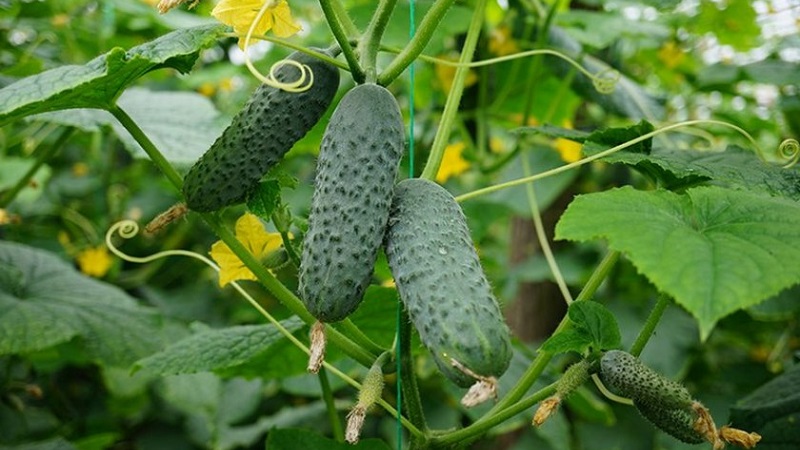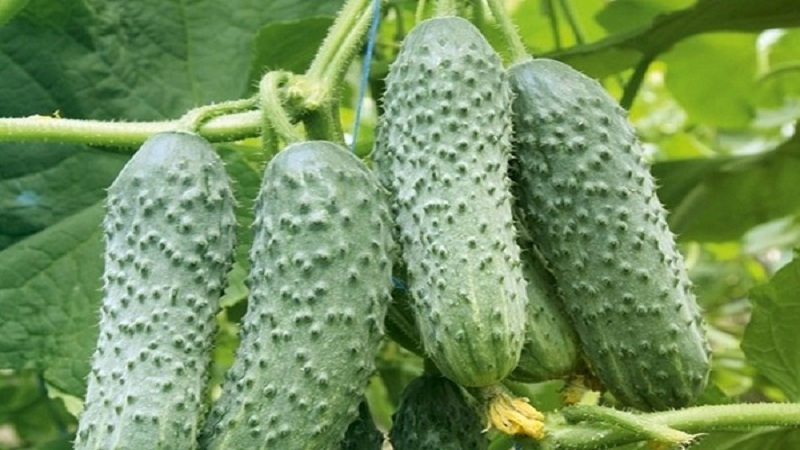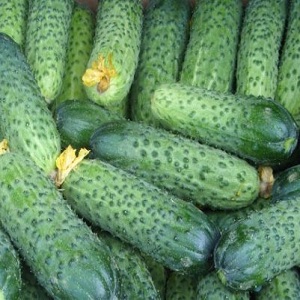Dutch hybrid cucumber "Cedric", recommended for growing in greenhouse conditions
Cucumber Cedric f1 appeared on the market recently, but has already gained popularity among gardeners due to its high productivity and long-term fruiting in greenhouse conditions. The fruits have an attractive presentation and excellent taste without bitterness. Immunity to major crop diseases makes it easier to care for the bushes. When cultivating, it is important to apply top dressing in a timely manner, water the plants regularly, and observe the temperature regime.
The content of the article
Description of the hybrid
The Cedric f1 hybrid was developed by Dutch breeders of the Enza Zaden company. Culture was included in the State Register of Russia in 2015. Cucumbers are recommended for cultivation throughout the country, in greenhouses and hotbeds in the spring-summer turnover (autumn-winter - in greenhouses with heating).
Features:
Indeterminate bushes require shaping and tying to the trellis. The plant is medium-branched, with a female flowering type and a powerful rhizome. In one node, 2–4 ovaries are formed.
The culture is highly productive, therefore it needs constant feeding mineral complexes. Fruits are set even in unfavorable conditions (with jumps in the average daily temperature, lack of sunlight).
The photo shows a Cedric cucumber.

The table shows the main characteristics of the hybrid:
| Indicators | Characteristic |
| Ripening period | 40-45 days |
| Pollination type | Parthenocarpic |
| Weight | 100-105 g |
| Length | 12-14 cm |
| The form | Cylindrical |
| Coloration | Green with short light stripes |
| Leaves | Medium green |
| Pulp | Thick crispy |
| Taste | Sweetish, without bitterness |
| Skin | Dense, with small tubercles and white spines |
| Appointment | For fresh consumption and canning |
| Yield | 15-16 kg / m² |
| Sustainability | To cladosporium disease, powdery mildew, cucumber mosaic virus |
| Transportability | High |
Composition and properties
Nutritional value of cucumbers (per 100 g):
- calorie content - 14 kcal;
- proteins - 0.8 g;
- fats - 0.1 g;
- carbohydrates - 2.5 g;
- water - 95 g;
- fiber - 1 g.
Vitamin and mineral composition table:
| Name | Content | Norm |
| Vitamin A | 10 mcg | 900 mcg |
| Beta carotene | 0.06 mg | 5 mg |
| Vitamin B1 | 0.03 mg | 1.5 mg |
| Vitamin B2 | 0.04 mg | 1.8 mg |
| Vitamin B4 | 6 mg | 500 mg |
| Vitamin B5 | 0.27 mg | 5 mg |
| Vitamin B6 | 0.04 mg | 2 mg |
| Vitamin B9 | 4 μg | 400 mcg |
| Vitamin C | 10 mg | 90 mg |
| Vitamin E | 0.1 mg | 15 mg |
| Vitamin H | 0.9 μg | 50 mcg |
| Vitamin K | 16.4 μg | 120 mcg |
| Vitamin PP | 0.3 mg | 20 mg |
| Potassium | 141 mg | 2500 mg |
| Calcium | 23 mg | 1000 mg |
| Silicon | 53 mg | 30 mg |
| Magnesium | 14 mg | 400 mg |
| Sodium | 8 mg | 1300 mg |
| Sulfur | 6.5 mg | 1000 mg |
| Phosphorus | 42 mg | 800 mg |
| Chlorine | 25 mg | 2300 mg |
| Iron | 0.6 mg | 18 mg |
| Iodine | 3 μg | 150 mcg |
| Cobalt | 1 μg | 10 mcg |
| Manganese | 0.18 mg | 2 mg |
| Copper | 100 mcg | 1000 mcg |
| Molybdenum | 1 μg | 70 mcg |
| Selenium | 0.3 μg | 55 mcg |
| Fluorine | 17 mcg | 4000 mcg |
| Chromium | 6 μg | 50 mcg |
| Zinc | 0.215 mg | 12 mg |
The benefits of fruits for the body:
- normalization of water and electrolyte balance;
- getting rid of heartburn;
- replenishment of the deficiency of minerals, vitamins;
- improving digestive function;
- normalization of the thyroid gland;
- removal of excess fluid from tissues;
- whitening of freckles when applied externally;
- lowering cholesterol levels.
Agrotechnics
The culture is grown in seedlings and by direct sowing into the ground. Planting care involves frequent loosening, weeding, sufficient watering, organic and mineral fertilizing.The hybrid is resistant to the main diseases of the culture, which greatly facilitates its cultivation.
Seed planting
Cucumbers are grown on fertile, loamy and loose soils. It is difficult to observe crop rotation indoors. More often, the plants are simply swapped from year to year. In such conditions, the soil is quickly depleted, pathogenic microflora accumulates. Farmers replace the top layer of land with a new one, but this procedure requires labor and money.
Simplifies the seeding task siderates... Legumes, white mustard and oil radish restore soil fertility. Oats fills the soil with nitrogen, potassium and phosphorus, inhibits the development of nematodes.
In the fall, they dig up the ground in the greenhouse, sow green manure. The green mass is growing rapidly. After a month, the plants are mowed and embedded in the ground. To accelerate decay, water with a solution of the drug "Baikal-EM".
Seeds do not need disinfection, since all Dutch-made planting material is pre-processed. Sowing is carried out in late May or early June. The air temperature should warm up to at least +20 ° С, the soil temperature - up to +16 ° С.
A bayonet shovel is used to dig up the site. The beds are formed 70 cm wide and 20 cm deep. Peat, sawdust and chicken droppings (10 l / 1 m²) are added for replenishment. Rake to level the surface, slightly crush. In the middle, a depression of 2-3 cm is formed, where it is poured with a hot solution of potassium permanganate for disinfection.
Seeds are planted to a depth of 2-3 cm, at a distance of 25 cm from each other, slightly pressed into the soil with the palm of your hand. Damp earth is poured on top and covered with agrofibre to protect it from frost.
Seedling planting
Sowing seeds for seedlings is carried out in mid-April. Use peat containers of 500 ml or cassettes 10x10 cm. The container is filled with a moist soil mixture of 2 parts of soil, humus and 1 part of river sand.
Seeds are sealed one at a time, to a depth of 1.5 cm. Polyethylene is pulled from above and taken to a dark place. The optimum temperature for fast emergence is + 27 ° C.
After the emergence of sprouts, the shelter is removed, the containers are taken out onto the windowsill on the south side of the house. The first 5 days the temperature is gradually reduced: during the day - up to + 15 ... + 18 ° С, at night - up to + 12 ... + 14 ° С. This prevents the seedlings from pulling out.
Seedlings are watered with warm clean water once a week.
After the appearance of 4 true leaves, the seedlings dive into the greenhouse. The soil is prepared in the same way as for direct sowing. Planting scheme - 20x60 cm, 3 bushes per 1 m². The roots are huddled, lightly tamped and watered abundantly with water.
Reference! Cedric is grown in open ground in seedlings, provided that the soil warms up to +16 ° C. The method is suitable for southern regions.
Growing and care

Crop care rules:
- The temperature in the greenhouse is maintained not lower than +20 ° С.
- Bushes watered under the root with warm rain or settled water, they organize a drip humidification system, combining water with mineral dressings.
- Loosening and weeding is carried out regularly. Weeds are removed by the root.
- To maintain a high level of productivity, the bushes are formed and tied to a trellis.
- During the growing season, the plants are fed at least 5 times, alternating organic matter and mineral mixtures.
The table shows the diagram top dressing cucumbers:
| Stage of development | Fertilizer | Application |
| Before flowering | Agricola-5 | 1 tbsp. l. 10 liters of water. Process the bushes once. |
| During flowering | Superphosphate, urea and potassium sulfate | 1 tsp. powder per 10 liters of water. Use for watering once, apply 10 days after the first feeding. |
| During fruiting | Agricola-Vegeta | 1 tbsp. l. 10 liters of water. Consumption for 1 m² - 5 liters. |
| Cow dung, potassium sulfate | 500 ml of manure, 1 tsp. potassium sulfate per 10 liters of water. Consumption for 1 m² - 5-6 liters. | |
| Nitrofoska and "Barrier" | 1 tbsp. l. nitrophoski, 2 tbsp. l. liquid finished fertilizer for 10 liters of water. Consumption for 1 m² - 6-9 liters. | |
| "Fertility", "Agricola-5" | 1 tbsp. l. ready-made fertilizers for 10 liters of water.Consumption for 1 m² - 5 liters. |
Features of cultivation and possible difficulties
The hybrid is hardy, quickly adapts to growing conditions. Parthenocarpic needs a garter and proper shaping of the bushes:
- The first 5-6 leaf sinuses blind (remove ovaries and shoots).
- In cloudy cool weather, blinding is carried out at 7-8 nodes.
- The main stem is led to the trellis, removing the stepsons and leaving only the ovaries.
- When the crossbar is reached, the stem is wrapped around it, pinched after 3-5 leaves are formed or thrown over the bar and pinched the crown a meter from the ground.
- The bottom dry and yellow leaves are removed in the early morning.
Diseases and pests
The Cedric hybrid is immune to cladosporiosis, powdery mildew, and cucumber mosaic virus. For preventive purposes, a number of procedures are performed:
- greenhouses are fumigated with sulfur bombs in autumn;
- the ground is disinfected with copper sulfate (50 g of powder per 10 liters);
- observe crop rotation, plant green manure;
- control the level of nitrogen in the soil;
- regulate humidity indoors;
- mineral dressing is timely applied.
The plant is susceptible to attacks by melon aphids, spider mites, whiteflies, and cucumber gnats. The table contains the main signs of infection and methods of insect control:
| Pest | Signs | Treatment |
| Cucumber gnat | Holes on cotyledon leaves, white larvae (6 mm) on the reverse side, wilting of plants. | Treatment of bushes with "Aktara" in the first days after planting. Sticky yellow tapes hanging from the ceiling help. |
| Spider mite | Small white dots on the back of leaves, thin cobweb on bushes. | Fill a bucket ½ with dry marigold flowers, pour warm water. After 48 hours, add 25 g of liquid soap. Use for processing once a week.
Apply "Bitoxibacillin" twice a season. The drug is safe for bees and humans. |
| Aphid | Drooping leaves, drops of honeydew, a large concentration of ants. | Grind 500 g of the roots and green part of the dandelion in a meat grinder, pour 5 liters of water. After 4 hours, stir in 2 tbsp. l. mustard powder. Process the bushes once every 5-7 days.
|
| Whitefly | Sticky bloom on stems and leaves, many white larvae at an early stage, schools of white moths at a later stage. | 100 g of dry grass dope ordinary pour 1 liter of warm water. Strain after 10-12 hours. Process the plants once every 10 days.
|
Harvesting and application of the crop
The picking of cucumbers is carried out every 3 days to preserve further crop productivity. The first fruits are removed 40 days after sprouting. The bushes bear fruit before the onset of cold weather.
The dense structure of cucumbers without voids and bitterness allows them to be used for pickling, pickling for the winter. Fruits with a sweetish crispy pulp are great for making seasonal salads, vegetable cuts.
The harvest is stored in the cellar for about 2 weeks. During transportation, cucumbers do not lose their presentation.
Advantages and disadvantages

Hybrid advantages:
- early ripening;
- versatility in cooking;
- fruits do not outgrow, do not barrel;
- resistance to major diseases of culture;
- stress resistance;
- abundant fruiting;
- lack of bitterness in fruits;
- high transportability and keeping quality.
Disadvantages - the need for pinching and garters to the trellis.
Reviews
The Cedric hybrid appeared on the domestic seed market recently, but many gardeners have already tried it out in business:
Vladimir, Penza: «I grow cucumbers for sale. Last year, I planted several new varieties and hybrids in the greenhouse, including Cedric. Cucumbers began to ripen 40 days after germination. I alternated organics and minerals for feeding. The bushes did not hurt at all, they bore fruit steadily.
Natalia, Engels: “I planted a hybrid through seedlings in a greenhouse. Seed germination - 100%. I did not light up the seedlings, watered them in moderation, did not fertilize them with anything. She grew up healthy and strong. Cucumbers taste excellent, do not taste bitter, suitable for canning... When growing, it is important to form the bushes correctly, not to shade them. Plants love warmth and sun. "
Andrey, Yelets: “I sowed seeds directly into the ground in the greenhouse at the end of May. Flower ovaries began to appear after 35 days, the first fruits were harvested after 50 days. The bushes were fed with organic and ready-made mineral fertilizers. Watered 2-3 times a week. Cucumbers do not outgrow, there are no voids inside, the seeds are small. "
Conclusion
The early maturing "Dutchman" Cedric f1 is suitable for indoor and outdoor cultivation in spring-summer and autumn-winter rotation. The culture is undemanding to the composition of the soil, pleases with prolonged fruiting, persistent immunity to major diseases. Cucumbers do not outgrow, do not barrel, and retain their presentation and taste for a long time.
Parthenocarpic does not need bees pollination, so it is ideal for indoor use. Compliance with pinching technology allows you to maintain a high level of fruiting.